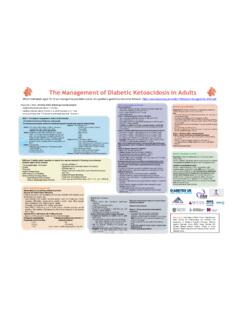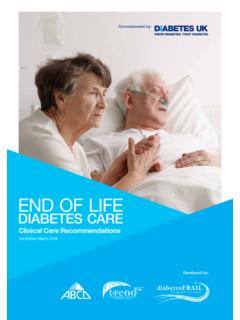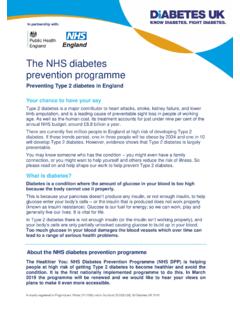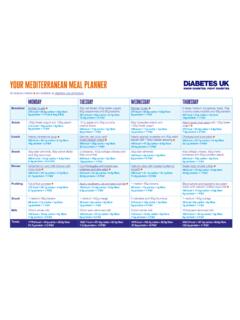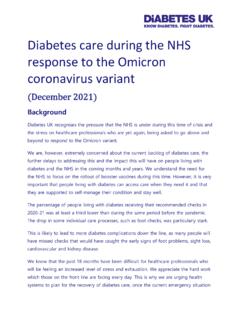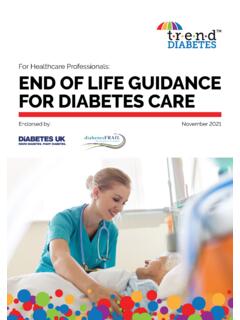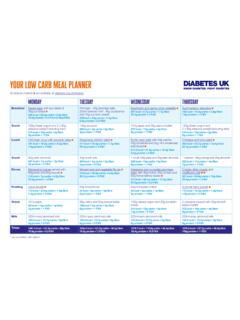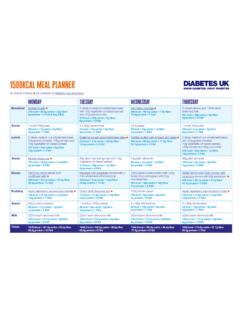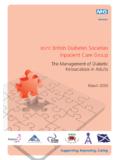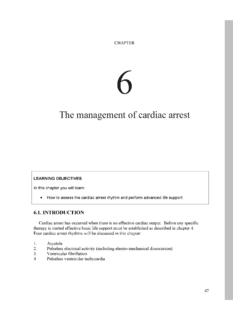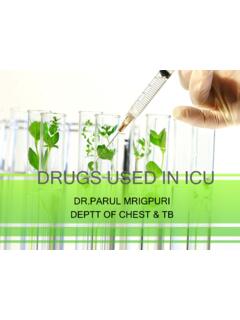Transcription of The Management of Diabetic Ketoacidosis in Adults*
1 The Management of Diabetic Ketoacidosis in Adults* Revised June 2021*For 16-18 year oldsUse this guideline if managed by the adult diabetes team but if managed by the paediatric team follow: 2 The hospital Management of hypoglycaemia in adults with diabetes mellitus JBDS 01 The Management of Diabetic Ketoacidosis in adults JBDS 02 Management of adults with diabetes undergoing surgery and elective procedures: improving standards JBDS 03 Self- Management of diabetes in hospital JBDS 04 Glycaemic Management during the inpatient enteral feeding of stroke patients with diabetes JBDS 05 The Management of the hyperosmolar hyperglycaemic state (HHS)
2 In adults with diabetes JBDS 06 Admissions avoidance and diabetes: guidance for clinical commissioning groups and clinical teams JBDS 07 Management of hyperglycaemia and steroid (glucocorticoid) therapy JBDS 08 The use of variable rate intravenous insulin infusion (VRIII) in medical inpatients JBDS 09 Discharge planning for adult inpatients with diabetes JBDS 10 Management of adults with diabetes on the haemodialysis unit JBDS 11 Management of glycaemic control in pregnant women with diabetes on obstetric wards and delivery units JBDS 12 The Management of diabetes in adults and children with psychiatric disorders in inpatient settings JBDS 13A good inpatient diabetes service JBDS 14 Inpatient care of the frail older adult with diabetes JBDS 15 Diabetes at the front door JBDS 16 The Management of
3 Glycaemic Control in Patients with Cancer JBDS 17 This document is coded JBDS 02 in the series of JBDS documents:Other JBDS documents:These documents are available to download from the ABCD website , the Diabetes UK website at and the chemotherapy board website at guidelines can also be accessed via the Diabetologists (ABCD) app (need ABCD membership to access the app) @JBDSIP for inpatient guidelinesThese guidelines have been developed to advise the treatment and Management of Diabetic Ketoacidosis in guideline recommendations have been developed and reviewed by a multidisciplinary team led by the Joint British Diabetes Society (JBDS) and including representation from Primary Care Diabetes Society, Diabetes UK.
4 People with diabetes have been involved in the development of the guidelines via stakeholder events organised by Diabetes is intended that the guideline will be useful to clinicians and service commissioners in planning, organising and delivering high quality diabetes inpatient care. There remains, however, an individual responsibility of healthcare professionals to make decisions appropriate to the circumstance of the individual, informed by them and/or their guardian or carer and taking full account of their medical condition and implementing this guideline full account should be taken of the local context and in line with statutory obligations required of the organisation and individual. No part of the guideline should be interpreted in a way that would knowingly put staff, those with diabetes or anyone else at statementThese guidelines are free for anyone to distribute, amend and use.
5 However, we would encourage those who use them to acknowledge the source of the document and cite the Joint British Diabetes Societies for Inpatient Care and the UK Chemotherapy Board. The Guidelines produced by the Joint British Diabetes Societies for Inpatient Care are licensed under CC BY-NC DisclaimerThe information contained in this guidance is a consensus of the development and consultation groups views on current treatment. It should be used in conjunction with any local policies/procedures/guidelines and should be approved for use according to the trust clinical governance process. Care has been taken in the preparation of the information contained in the guidance. Nevertheless, any person seeking to consult the guidance, apply its recommendations or use its content is expected to use independent, personal medical and/or clinical judgement in the context of the individual clinical circumstances, or to seek out the supervision of a qualified clinician.
6 The group makes no representation or guarantee of any kind whatsoever regarding the guidance content or its use or application and disclaim any responsibility for its use or application in any enable the guideline to stay relevant, it is envisaged that all of the JBDS guidelines will be updated or reviewed each year. As such these are living documents designed to be updated based on recently published evidence or experience. Thus, feedback on any of the guidelines is welcomed. Please email with any comments, suggestions or queries. Conflict of interest statementThe authors declare no conflicts of interest4 Lead authorshipProf Ketan Dhatariya, Norfolk and Norwich University Hospitals NHS Foundation TrustPrevious authorsDr Mark Savage, Bendigo Health, AustraliaSupporting organisationsAssociation of British Clinical Diabetologists (ABCD), Chair: Dr Dipesh Patel (Royal Free, London)Diabetes Inpatient Specialist Nurse (DISN) UK Group, Chair: Erwin Castro (East Sussex) Diabetes UK: David Jones, Assistant Director Policy, Campaigns and ImprovementJoint British Diabetes Societies (JBDS) for Inpatient Care, Chair.
7 Professor Ketan Dhatariya (Norwich) Writing group of previous versionsAnne Claydon, Barts Health NHS Trust Dr Philip Dyer, Heart of England NHS Foundation TrustDr Philip Evans, Pontypridd and Rhondda NHS TrustDr Atir Khan, Hywel Dda Health BoardDr Anne Kilvert, Northampton General Hospital NHS TrustDr Nicky Leech, The Newcastle upon Tyne Hospitals NHS Foundation TrustDr Nicholas Levy, West Suffolk Hospitals NHS Foundation TrustDr Gerry Rayman, The Ipswich Hospitals NHS TrustDr Alan Rees, Cardiff and Vale University Health BoardDr Maggie Sinclair-Hammersley, Oxford University Hospitals NHS TrustThanks also to:Northern Irish DiabetologistsSociety for Acute MedicineWelsh Endocrine and Diabetes SocietyScottish Diabetes GroupDistributed and incorporated comments from.
8 Diabetes Inpatient Specialist Nurse (DISN) UK Group membershipJoint British Diabetes Societies (JBDS) Inpatient Care steering committee membersDiabetes UKAssociation British Clinical Diabetologists (ABCD)United Kingdom Clinical Pharmacy Association (UKCPA) Diabetes & Endocrinology CommitteeGuild of Healthcare Pharmacists (GHP)Royal College of Physicians (RCP)Training, Research and Education for Nurses in Diabetes (TREND Diabetes)Ambulance Service NetworkDiabetes Nurse Consultants GroupSociety for Acute MedicineIntensive Care SocietyRoyal College of NursingWe would also like to thank the service user representatives whose input has informed the development of these statement 3 Foreword 7 Changes since the 2013 guidance 8 Uptake of the 2010 and 2013 guidelines 8 Single page treatment pathway for DKA 9 Introduction 10 Diagnosis of DKA 10 Rationale for current practice 11 Ketones and acidosis 11 Euglycaemic DKA 11 Ketosis prone type 2 diabetes
9 11 Differential diagnosis 12 Point of care testing ( bedside monitoring ) 12 The involvement of diabetes specialist teams 13 General Management issues 13 Fluid administration and deficits 13 Insulin therapy 14 Metabolic treatment targets 15 Intravenous glucose concentration 15 Special groups 15 Other considerations 16 Recurrent DKA 16 Controversial areas 17 Recommendations 171. Reduce the rate of insulin infusion to units/kg/hr when glucose drops to < mmol/L 182. Colloid versus crystalloid? 183. sodium chloride solution or balanced crystalloid solution for resuscitation? 184.
10 Rate of fluid replacement? 195. Intravenous bicarbonate? 196. Use of intravenous phosphate? 207. What should the rate of glucose lowering be? 206 Complications of DKA and its treatment 201. hypokalaemia and hyperkalaemia 202. Hypoglycaemia 213. Cerebral oedema 214. Other complications 21 The Management of DKA in people with end stage renal failure or on dialysis 22 Fluid replacement 22 Insulin treatment 22 Potassium 22 DKA pathway of care 23 Assessment of severity 230 to 60 minutes: Immediate Management upon diagnosis 2460 minutes to 6 hours 276 to 12 hours 2912 to 24 hours 30 Pathophysiology of DKA 32 Epidemiology and cost 32 Mortality and morbidity 32 Implementation of the guidelines 33 Commissioning of care 33 Audit 33 Quality indicators 33 References 34 Appendix 1 39 Appendix 2 41 Appendix 3 44 Example intravenous insulin prescription and fluid protocol 45 Example Management chart for the Management of DKA 487 Diabetic Ketoacidosis (DKA) is a frequent and potentially life-threatening complication of type 1 diabetes.
